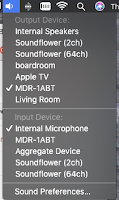The issue is that, although a headset might have implemented the AptX codec with great quality sound otherwise, because it is a headset, and it needs to be able to work with A2DP for the Microphone to work with all phones etc. The moment it does this, the sound output quality drops as well.
 The easy way to fix this is to switch your Input from Bluetooth to Internal Microphone. To do this, Hold in Option, and click on the Sound icon in the menu bar (or go to the Sound Preferences).
The easy way to fix this is to switch your Input from Bluetooth to Internal Microphone. To do this, Hold in Option, and click on the Sound icon in the menu bar (or go to the Sound Preferences).
But it is annoying to do this every time...
To fix this some people have devised scripts to detect this, and switch it back, but this would require automation software and some fiddling. Which you either may not want to do, or are unable to do.
I may have found another way to fix this without using scripts or apps.
Open the standard "Audio MIDI Setup.app" utility, and click the + at the bottom to create an "Aggregate Device". Then select the Internal Microphone as the only component in this aggregate device and select that as the default input.
For some reason this prevents Mac OS X from selecting the Bluetooth Microphone from now on and it will stay on the internal (via the aggregate) one when you reconnect.
Let me know if this works consistently for you... so far it's been working fine for me. You can also rename your "Aggregate Device" to "Microphone" for extra points.
 The easy way to fix this is to switch your Input from Bluetooth to Internal Microphone. To do this, Hold in Option, and click on the Sound icon in the menu bar (or go to the Sound Preferences).
The easy way to fix this is to switch your Input from Bluetooth to Internal Microphone. To do this, Hold in Option, and click on the Sound icon in the menu bar (or go to the Sound Preferences).But it is annoying to do this every time...
To fix this some people have devised scripts to detect this, and switch it back, but this would require automation software and some fiddling. Which you either may not want to do, or are unable to do.
I may have found another way to fix this without using scripts or apps.
Open the standard "Audio MIDI Setup.app" utility, and click the + at the bottom to create an "Aggregate Device". Then select the Internal Microphone as the only component in this aggregate device and select that as the default input.
For some reason this prevents Mac OS X from selecting the Bluetooth Microphone from now on and it will stay on the internal (via the aggregate) one when you reconnect.
Let me know if this works consistently for you... so far it's been working fine for me. You can also rename your "Aggregate Device" to "Microphone" for extra points.

Comments